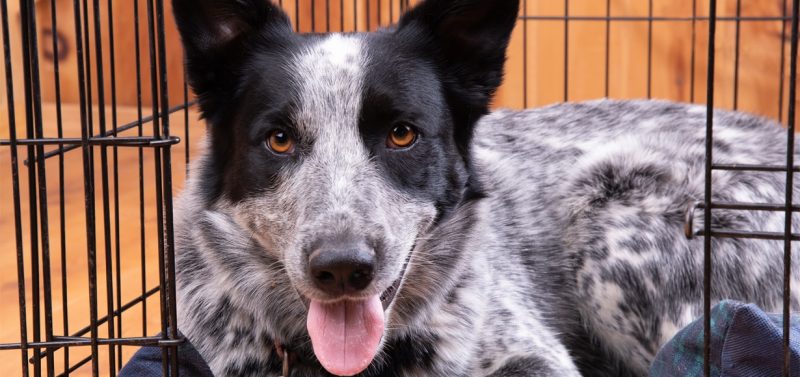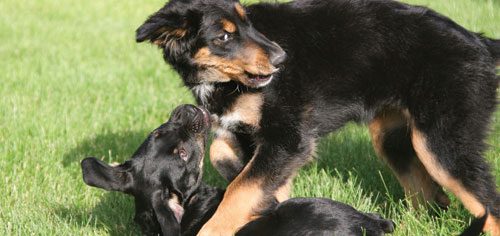

Why Are Dogs So Friendly? Science Now Has An Answer
Pet dogs have altered genes that make them friendlier than wolves, a new study demonstrates
Early last fall, while wildfires were ravaging the state of California, a colleague, who is a clinical psychologist, had dropped by my home to help coordinate my participation in a fundraising effort to try to rescue some dogs that had become homeless because of the conflagration. She sat down on a window seat while I went into the kitchen to get her a cup of coffee. While I did so I paused for a moment to let my dogs in from the backyard. Quite predictably, they immediately ran to greet her.
By the time I brought the coffee out to her I found that my Nova Scotia Duck Tolling Retriever, Ranger, had jumped up onto the seat beside her and was licking her face so vigorously that he had removed a good bit of her makeup.
She laughed and pushed him away and back to the floor. “Friendliness is one thing,” she said, “but in dogs it seems to have reached a level of friendliness that might be called insanity, or at least some kind of mental aberration.”
While I took a moment to settle the dogs down, I said to her, “You know, there is some recent research which suggests that you may be right about ‘insane friendliness’ in dogs. Have you heard of Williams–Beuren Syndrome?”
“Sure,” she replied. “In the clinic we just call it Williams Syndrome. As I recall, it is a sort of friendliness mutation. It is rather rare—maybe in one out of every 10,000 to 20,000 people. There are some physical characteristics, such as elf-like facial features, and people with Williams Syndrome also seem to have some cognitive difficulties, at least when it comes to focusing on problems. However, to psychologists, the most interesting feature of this mental condition are the social-emotional behaviours which are quite the reverse of the fearful or aggressive responses that we clinicians are normally called upon to treat. Individuals with Williams Syndrome seem to lack any kind of social inhibition—in other words, they act as if they love everybody. They tend to seek the company of others quite enthusiastically and are usually described as being kind-spirited, empathizing with others’ distress, and are also caring and forgiving. They don’t seem to show the normal level of fear of strangers and tend to run up to and hug completely unfamiliar people. The technical term for the behaviours they are showing is hypersociability, which I suppose could be viewed as pathologically friendly.”
“The sociability of the dogs proved to be a detriment since they spent a significantly greater portion of the two minutes they were given to complete the task gazing at the human.”
I sat down and sipped on my coffee and said, “Well, in a series of articles that have come out over the past three or so years, a big research team made up of investigators from Princeton, Oregon State University, and a bunch of other places, noticed the similarity between the extremely friendly behaviour of dogs and the behaviours of people with Williams–Beuren Syndrome. They then went on to test to see whether the social behaviour of dogs might be influenced by the same factors that cause these behavioural deviations in people.”
I went on to explain that the team was headed by Bridget Von Holdt of the Department of Ecology and Evolutionary Biology at Princeton University. The investigators knew that Williams-Beuren Syndrome was a genetic problem. It is due to the deletion of part or all of a section of DNA on chromosome 7 in human beings. It includes about 29 genes. This same sequence appears on chromosome 6 in dogs, so the team looked for structural changes in that string of genes, such as deletions, insertions or transpositions of DNA to other locations.
To measure differences in the social behaviour among various canines, the researchers compared 18 randomly selected pet dogs to 10 wolves that had been in captivity for a long time and had become tame and relatively friendly towards humans. One of the tests they used was a very simple assessment of just how friendly the dogs and wolves were. During the test, a stranger or a person who was familiar to the animal sat quietly; the behaviour of the dogs or wolves toward that person was monitored. The dogs showed nearly twice as much friendliness, spending 63 percent of their time hovering within a meter of a familiar person seeking social contact, as opposed to only 35 percent for the wolves. When presented with a total stranger the results were similar with the dogs spending nearly twice as much time as the wolves being friendly (53 percent for dogs versus 28 percent for wolves).
The dogs and wolves were also given a problem-solving task which required them to figure out how to take the cover off of a box which contained a bit of sausage as a reward. Here the sociability of the dogs proved to be a detriment since they spent a significantly greater portion of the two minutes they were given to complete the task gazing at the human. Because of this only two of the 18 dogs tested solved the problem. The wolves, however, were not distracted by social behaviours or misdirected attempts at friendly interaction, and they immediately set to work. Thus nine out of the 10 wolves solved the problem. An interesting feature of this is that people with Williams–Beuren Syndrome also show a lack of persistence on cognitive tests, perhaps due to the same social distractibility.
Once they had confirmed the behavioural differences in sociability between dogs and wolves, the team next needed to see if the expected genetic differences were also present. To do this, samples of DNA were taken from both the dogs and wolves for analysis. Looking at the targeted sections of the chromosomes, the researchers found that the DNA varied widely in the dogs, and to a lesser degree in wolves, at least as far as parts inserted, deleted, or duplicated. People with Williams–Beuren Syndrome also show great variation in the critical region of the chromosome, and the degree of variation is thought to affect the severity of the condition and its impact on the person’s personality. This also seems to be true in the wolves and the dogs. The hypersocial and friendly dogs had more DNA disruptions in the relevant regions than the more aloof wolves. Specifically, the most significant disruptions were on the gene that is associated with a protein called GTF21 (which in turn regulates the activity of a number of other genes). Higher levels of disruption in that critical region of the chromosome were associated with the most social dogs. A relative lack of change in that gene seems to lead to standoffish and the more distant and aloof behaviour that we tend to associate with wolves.
In more recent research, these researchers looked at the genetic code of 298 domestic and wild canines. One of the characteristic behaviours associated with wild canines, such as wolves or jackals, is that they are xenophobic. That is the technical term for being fearful of strangers, meaning that wild canines become frightened or wary when they encounter people, and because of this they tend to try to avoid them. This is, of course, the exact opposite of what we see in our dogs. This research team offered the idea that during the process of domestication, because we wanted dogs to be sociable and approachable, we systematically bred animals which have the genetic mutations that predispose dogs to be abnormally friendly.
I think that I must’ve chuckled before I noted, “In other words, the researchers concluded that the genetic disruption that produces Williams–Beuren Syndrome in people (which we define as a ‘deviant mental condition’), has now become ‘normal’ in dogs and accounts for their persistent friendliness towards humans. It’s also likely that this genetic condition is a contributor toward producing the personality type which allows us to domesticate dogs in the first place and for them to form an affectionate bond with humans. Put simply, it means that your suggestion that dogs are ‘insanely friendly’ might not be far from the truth.”
I was interrupted by a giggling sound and looked up to find that Ranger had jumped back up on the window seat next to my colleague and was now affectionately licking the remaining makeup off of the other side of her face.
Join the newsletter and never miss out on dog content again!
"*" indicates required fields
By clicking the arrow, you agree to our web Terms of Use and Privacy & Cookie Policy. Easy unsubscribe links are provided in every email.








